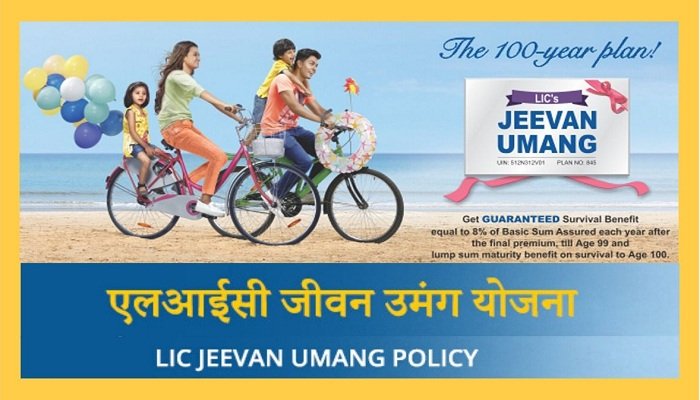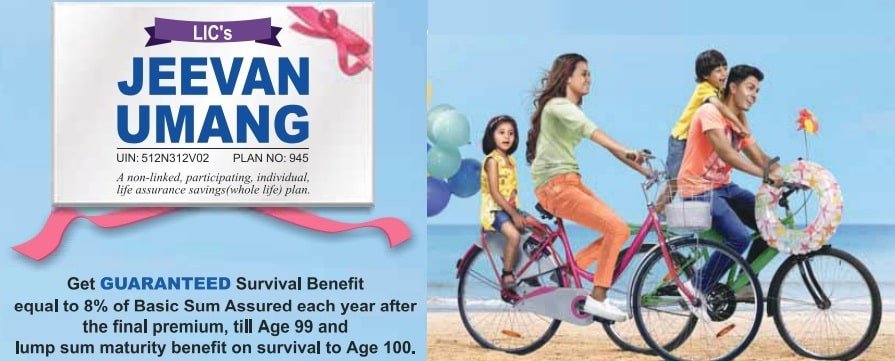LIC Jeevan Umang Policy Online Apply | LIC Jeevan Umang Policy Intrest Rates | LIC Jeevan Umang Policy Intrest Rates Calculator | LIC Jeevan Umang Policy Premium Chart
LIC Jeevan Umang is a non-linked, participation whole life assurance plan that provides the policyholder family with both revenue and insurance coverage. The policy went into effect on February 1, 2020. After the premium payment period is completed, the LIC Jeevan Umang plan gives annual survival benefits until maturity. Read below to check the detailed information related to LIC Jeevan Umang Policy like Highlights, Objectives, Features, Benefits, Eligibility Criteria, and much more.
Table of Contents
LIC Jeevan Umang Policy – Comprehensive Details
LIC Jeevan Umang is an investment cum entire life plan that pays out on a routine basis from the end of the premium payment term until your death. This plan qualifies for the Simple Reversionary Bonus and the Final Addition Bonus as a participating plan. The Jeevan Umang plan from LIC provides your family with both revenue and security. This plan offers a yearly survival advantage from the end of the premium-paying period until maturity, as well as a lump sum payment at maturity or throughout the policyholder’s life. The plan offers a lump sum payment as a maturity reward and a death benefit during the policy’s term, in addition to the survivor benefit Furthermore, this plan addresses liquidity requirements through a lending facility.

Benefits of LIC Jeevan Umang Policy
Some of the key benefits of the LIC Jeevan Umang Policy are as follows:
- If the policyholder dies before the “Risk Commencement Date,” the nominee will get a refund of all premiums paid. The nominee will receive the Sum Assured on Death if the policyholder dies after the “Risk Commencement Date.”
- When the policyholder reaches the age of 100, he or she will get the Sum Assured + Simple Reversionary Bonus + Final Addition Bonus.
- Once this policy has a Surrender Value, you will be able to receive a loan against it. Only after three years of premiums have been paid does this plan receive a Surrender Value. The loan amount and interest rate will be determined by the market conditions at the time the loan is taken out.
- After a year of premium payments, the policyholder will begin to receive 8% of the Basic Sum Assured each year. This sum is due each year until he reaches the age of 100 or dies, whichever comes first.
Highlights of LIC Jeevan Umang Policy
| Name | LIC Jeevan Umang Policy |
| Launch Date | 20th April 2017 |
| Table Number | 845 |
| Product Type | Endowment + Whole life |
| UIN | 512N312V01 |
| Bonus | Yes |

Features of LIC Jeevan Umang Policy
Some of the key features of the Jeevan Umang Policy are as follows:
- The plan combines the advantages of normal income with insurance coverage.
- The plan allows you to select from a variety of premium payment terms, including 15 years, 20 years, 25 years, and 30 years.
- The LIC Jeevan Umang insurance includes a simple reversionary bonus as well as a final supplementary bonus, if applicable.
- The policy offers insurance for the policyholder’s entire life, up to 100 years.
Eligibility Criteria for LIC Jeevan Umang Plan
Applicants who want to apply for the LIC Jeevan Umang Policy must fulfill the eligibility criteria put forward by the Government of India. The eligibility criteria for the Policy are as follows:
| Eligibility Criteria | Minimum | Maximum |
| Entry Age | 90 days | 55 years |
| Policy Term | 100 years- Age at entry | |
| Maturity Age | 100 years | |
| Sum Assured | Rs. 2,00,000 | No limit |
| Premium paying term | 15 years, 20 years, 25 years, and 30 years | |
| Age at the end of premium paying term | 30 years | 70 years |
Required Documents for LIC Jeevan Umang Policy
While filling up the application form for LIC Jeevan Umang Policy, some important documents will be needed by the applicants, make sure to keep them handy. The documents required for Umang Policy are as follows:
- Age Proof
- Address Proof
- Medical Diagnosis Reports as required
- Properly filled Proposal form/ Application form
- Medical History
- Other KYC documents: Adhaar Card, PAN Card, Tax Details, etc.
LIC Umang Jeevan Policy Exclusions
The Jeevan Umang policy does not cover any claims filed in the event of the policyholder’s suicide.
- If the policyholder commits suicide within the first twelve months of the policy’s commencement, the candidate will get 80% of the payments made so far, provided the insurance is still active.
- If a policyholder commits suicide after twelve months has passed since the policy was revived, the higher the payments made up to that point, or the accumulated surrender value will be paid.
Policy Revival
The coverage will expire if payments are not paid on time, even during the grace period. A lapsed policy can be resurrected after two years from the date of the first unpaid premium but before the policy’s Maturity date. You’ll have to pay the full amount due, plus interest (compounding half-yearly) at a rate set by LIC.
Value Paid-Up:
- If the insurance has not been renewed after less than three years of payments paid, all advantages under the policy will stop when the lapse period expires, and nothing will be granted.
- If at least three full years’ premiums were paid and any subsequent payments have not been paid on time, the policy will not be canceled and will continue to be a paid-up insurance until the policy term expires.
- A paid-up policy’s Sum Assured on Maturity is lowered to a sum known as the “Maturity Paid-up Sum Assured,” which is equal to [(Number of premiums paid /Total number of premiums payable)*(Sum Assured on Maturity)].
- A paid-up policy’s Sum Assured on Death is lowered to a sum known as the “Death Paid-up Sum Assured,” which is equivalent to [(Number of premiums paid /Total number of premiums payable) * Sum Assured on Death].
Free Look Period
If the Policyholder is dissatisfied with the policy’s “Terms and Conditions,” he or she may return the policy to LIC within 15 days of receiving the policy bond, explaining the grounds for the complaints. After subtracting the proportional risk premium (for base plan and rider, if any) for the time on cover and stamp duty charges, LIC will cancel the policy and refund the amount of premium deposited.
Giving Up the Policy
The coverage can be canceled at any moment as long as the premiums have been paid for at least three years. LIC will pay the Surrender Value, which is higher than the Guaranteed Surrender Value, and the Special Surrender Value when the policy is surrendered. The Special Surrender Value is subject to change and may be decided by the Insurer at any time with IRDAI’s prior consent. The total premiums paid multiplied by the Guaranteed Surrender Value factor applicable to total premiums paid equals the Guaranteed Surrender Value payable during the insurance term. The Guaranteed Surrender Value components, expressed as percentages, will vary depending on the policy term and year of surrender.
Contact Us
For further details or in case of any query or complaint related to the LIC Jeevan Umang Policy, feel free to contact on the below-given details:
Registered Office:
- Life Insurance Corporation of India Central Office, Yogakshema,
- Jeevan Bima Marg, Mumbai – 400021
- Official website: Click Here
- Registration Number: 512
FAQ’s
· The Minimum Entry Age for the LIC Jeevan Umang Policy is 90 days
· TheMaximum Entry Age for the LIC Jeevan Umang Policy is 55 years
If the policyholder commits suicide, the following criteria will be followed:
· If the policyholder commits suicide within the first twelve months of the policy’s commencement, the candidate will get 80% of the payments made so far, provided the insurance is still active.
· If a policyholder commits suicide after twelve months has passed since the policy was revived, the higher the payments made up to that point, or the accumulated surrender value will be paid.